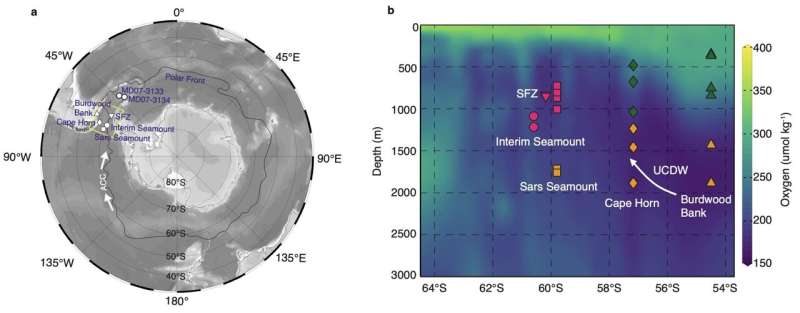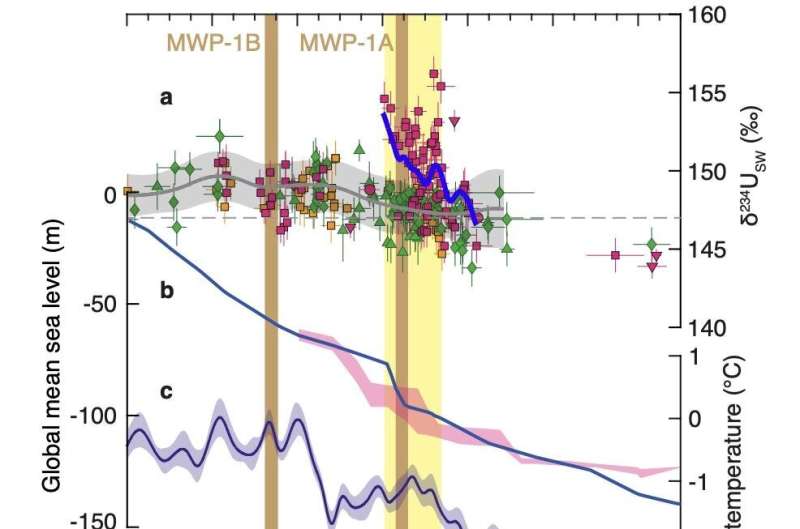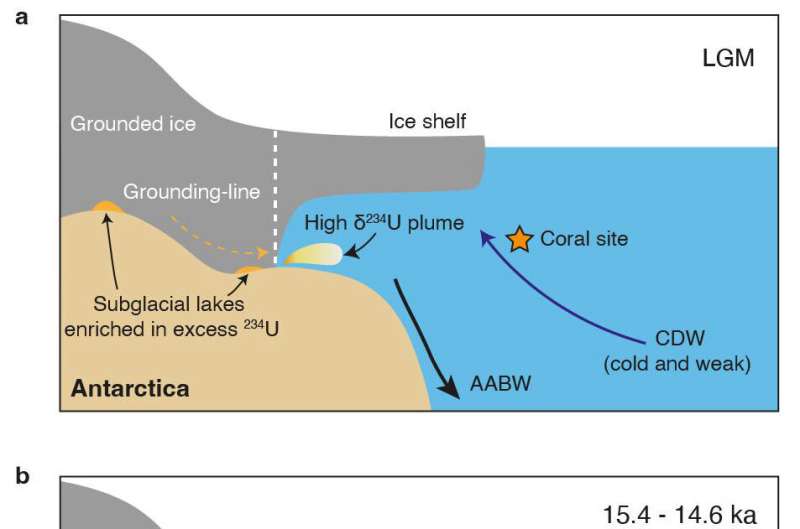This article has been reviewed according to Science X's editorial process and policies. Editors have highlighted the following attributes while ensuring the content's credibility:
fact-checked
peer-reviewed publication
trusted source
proofread
Deep-sea coral evidence found for enhanced subglacial discharge from Antarctica during meltwater pulse 1A

Subglacial discharge from the Antarctic Ice Sheet (AIS) likely played a crucial role in the loss of ice sheet and the subsequent rise in sea level during the last deglaciation. However, no direct proxy is currently available to document subglacial discharge from the AIS, which leaves significant gaps in our understanding of the complex interactions between subglacial discharge and ice sheet stability.
Recently, Assoc. Prof. Li Tao from the Nanjing Institute of Geology and Paleontology of the Chinese Academy of Sciences (NIGPAS), in collaboration with researchers from University of Bristol, University of St Andrews, and Nanjing University, carried out a high-resolution deep-sea coral 234U/238U records from the Drake Passage in the Southern Ocean to track subglacial discharge from the AIS. The findings provide an important reference for predicting possible future changes in the Antarctic ice sheet.
The study was published in Nature Communications on Nov. 13.
The uranium isotopic composition of seawater is a potential tracer for subglacial discharge and thus ice-sheet stability in the past. Due to the relatively mobile nature of 234U induced by a-recoil effects, 234U is preferentially released and transported to the ocean via riverine input, resulting in an enrichment of 234U relative to 238U in modern seawater. Within debris-laden basal ice and subglacial sediments, however, recoil rejection of 234U is maintained in either basal ice or subglacial waters, thus leading to a 234U-enriched reservoir beneath the ice sheets.

Given the widespread presence of subglacial lakes beneath AIS, the pool of excess 234U is expected to be considerable, and may have significantly impacted local seawater δ234U if it was released into the Southern Ocean during episodes of AIS retreat during the last deglaciation.
In the study, the researchers recovered deep-sea coral samples from seamounts in the Drake Passage, including two sites to the north of the Polar front (PF) (Cape Horn and Burdwood Bank), one site aligning with PF (Sars Seamount), and two sites to the south of the PF (Interim Seamount and Shackleton Fracture Zone). These samples were precisely dated by isotope dilution U-Th disequilibrium. This comprehensive geographic coverage allowed the researchers to investigate a range of oceanographic conditions and potential sources of δ234U anomalies.
The findings revealed distinctively higher seawater 234U/238U values from 15,400 to 14,000 years ago, corresponding to the period of the highest iceberg-rafted debris flux and the occurrence of the meltwater pulse 1A event. This correlation suggests a causal link between enhanced subglacial discharge, synchronous retreat of the AIS, and the rapid rise in sea levels. "We further demonstrated that the enhanced subglacial discharge and subsequent AIS retreat appear to have been preconditioned by a stronger and warmer Circumpolar Deep Water," said Li.
By analyzing 38 new samples from Sars Seamount 695 to 981 m and integrating these data with 335 existing U-Th measurements, the researchers investigated the presence of δ234U anomalies in the Southern Ocean at the highest possible temporal resolution. The results revealed a general increase in Southern Ocean seawater δ234U from the last glacial period to the early Holocene, with a glacial low of ~144.0‰ (~20 ka) to a value of ~148.9‰ during the early Holocene (~10 ka), followed by a gradual decreasing trend towards a modern value of 146.8‰.

This deglacial increase of seawater δ234U reflected the input of excess 234U relative to 238U to the global ocean, which has been linked to the intensified physical weathering resulting from the rapid retreat of ice sheets during the last deglaciation. Superimposed on the general deglacial trend is a remarkable spike in δ234U reaching up to ~155‰ from ~15.4 to 14 ka.
"We argued that this high δ234U signal cannot be fully explained by the advection of 234U-enriched water from other ocean basins for several reasons and is most likely caused by enhanced subglacial discharge from the AIS during this time period," said Li.
The researchers further demonstrated that this discharge occurred synchronously with the peak in iceberg-rafted debris originating from the Weddell Sea sector of the AIS and meltwater pulse 1A (MWP-1A, ~14.65 to 14.3 ka), which provides direct evidence supporting Antarctic contribution to MWP-1A during the last deglaciation.
By comparing the deep-sea coral δ234U record with several climate proxies, they underscored that a stronger and warmer Circumpolar Deep Water may have preconditioned this rapid AIS retreat and the release of meltwater, and thus highlighting the critical role of oceanic heat in driving major ice sheet retreat.
More information: Tao Li et al, Enhanced subglacial discharge from Antarctica during meltwater pulse 1A, Nature Communications (2023). DOI: 10.1038/s41467-023-42974-0
Journal information: Nature Communications
Provided by Chinese Academy of Sciences



















